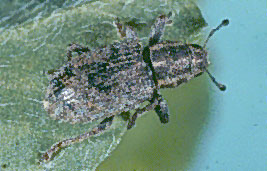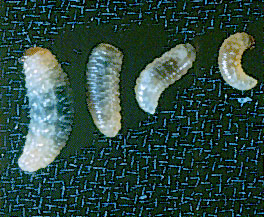Clover Root Curculio in Alfalfa
ENTFACT-119: Clover Root Curculio in Alfalfa | Download PDF
by Lee Townsend, Extension Entomologist
University of Kentucky College of Agriculture

Adult clover root curculios feed on plant foliage but most of the damage is caused by feeding of the larval stage on the root system. The grub-like larvae chew furrows which may entirely girdle the tap root of the plant.
Damage is usually most severe in young stands of alfalfa following a legume, where large numbers of larvae are present in the soil. These insects are usually not a significant problem in established fields, although heavily damaged clover and alfalfa may wilt and die during dry weather.
The adult stage, a narrow-bodied dark brown to black beetle, is about 0.2 inches long. The larval stage is a legless white grub with a brown head.
The insect can feed on all common clovers, alfalfa, soybeans, and some other legumes but they prefer red clover and white clover. There is one generation each year.
Life Cycle
Adults emerge from the soil in late June and leave alfalfa or clover fields for protected areas where they remain there until late August. From then through late October, they either crawl or fly back to nearby clover or alfalfa fields. The weevils will be active and lay some eggs during October and November and become inactive during the winter months.

Adults become active again during the first warm days in spring. Females lay most of their 300 to 500 eggs from March through June. All eggs are placed on the soil surface, usually within about 4" of the center of the plant crown.
Eggs begin to hatch in late March or early April. The small weevil larvae follow soil cracks down to roots or nodules. They are present in the soil from April until early June, feeding on progressively larger roots as they grow and ultimately damage the tap root. Most damage is done between surface and 4 inches deep.
Pupation occurs in earthen cells about 6 inches below the soil surface.
Losses
University of Kentucky research has shown that damage from the clover root curculio occurs during the first year of the stand in both spring and fall seedings. However, the actual stand loss does not show up until the summer following the first year of infestation. In spring seedings, the infestation develops during the following fall, winter, and spring with damage evident in the summer. In fall-seeded fields, infestation occurs that fall and winter and the following spring. After the initial damage, the weevils seem to cause no more stand loss.
Feeding by clover root curculio grubs reduces carbohydrate reserves of alfalfa during the larval feeding period and for about a month after below ground feeding has stopped. This probably contributes to stand loss during periods of stress, such as during a drought or immediately after cutting. Adequate root reserves are needed for winter survival, spring growth, and regrowth immediately after harvest. Seasonal yield loss (dry weight) is calculated at about 8% over the season. The greatest impact of clover root curculio on alfalfa may be the effect of larval feeding on root reserves and subsequent plant mortality during the growing season. Feeding damage to the root increases the severity of root rots. This can be an additional cause of declines in plant or stand vigor.
Management
Stand loss to clover root curculio can exceed 15% of the seedlings. Damage may be intense in some portions of the fields, such as along the margins, but slight in others. Soil moisture is a very important factor. Losses to clover root curculio can be significant when the stand is under drought stress but do not occur when soil moisture is adequate.
The lack of reliable means of assessing CRC infestations in fields makes it very difficult to determine the potential for economic losses. In addition, there are no registered insecticides to control or reduce the numbers of CRC larvae in infested fields. This makes the use of cultural controls the most practical way to manage minimize losses to CRC.
- Crop rotation Rotation of alfalfa or clover to grasses or row crops other than soybeans will remove the food source for larvae trapped in the soil and the types of plants that would stimulate adults to enter the field to lay eggs.
- Isolation from Existing Legumes New fields should be as far away from existing clover, alfalfa, or other legumes as practical. These fields will be sources of migrating beetles that can move in and become established in the fields.
- Spring Planting The late summer through fall flight of adult clover root curculios probably accounts for dispersal of the insects into new fields of alfalfa and red clover. The weevils can remain active until temperatures become too cool for flight in the fall. Consequently, spring seeding of alfalfa and red clover into new sites should be less susceptible to CRC damage than fall seedings.
Revised: 12/02
CAUTION! Pesticide recommendations in this publication are registered for use in Kentucky, USA ONLY! The use of some products may not be legal in your state or country. Please check with your local county agent or regulatory official before using any pesticide mentioned in this publication.
Of course, ALWAYS READ AND FOLLOW LABEL DIRECTIONS FOR SAFE USE OF ANY PESTICIDE!
Photos courtesy Lee Townsend, University of Kentucky Entomology
